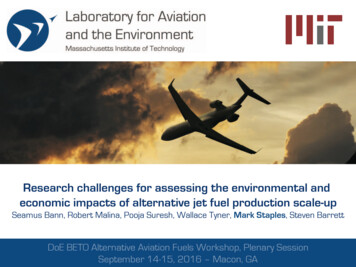
Transcription
Research challenges for assessing the environmental andeconomic impacts of alternative jet fuel production scale-upSeamus Bann, Robert Malina, Pooja Suresh, Wallace Tyner, Mark Staples, Steven BarrettDoE BETO Alternative Aviation Fuels Workshop, Plenary SessionSeptember 14-15, 2016 – Macon, GA1
Assessment of AJF technologiesLifecycle assessment (LCA) - quantifies GHG emissions of full fuel supply chainto estimate net climate change benefit of AJF vs. petroleum-derived jet fuelTechno-economic assessment (TEA) - quantifies fuel production cost, forcomparison to the cost of petroleum-derived jet fuelProcess-based, pathway specific methods of technology RefiningTransportation3
Results of TEA and LCA analyses(per unit of fuel)15.012.0HEFA yellow greaseHTL woody biomassHEFA tallowHEFA soybean oilFP corn stoverAF sugarcaneFT MSWAF corn grainAPP woody biomassAF herbaceous biomass9.0Minimumselling price[ 2015/gal]6.03.00.0*See end of the slides for references for these values.0.020.040.060.080.0Lifecycle GHG emissions [gCO2e/MJ]100.0120.0The impacts of large-scale AJF deployment aren’t captured.Preliminary results - do not cite or quote.6
Aviation industry GHG reductions from AJFTo what degree can AJF contribute to mitigating GHG emissionsfrom the aviation industry in the near- and long-term?1) AJF production assessment2) AJF lifecycle GHG assessmentPrimary waste andbioenergy potentialLifecycle GHGemissions of AJFLifecycle GHGemissions ofpetroleum jet fuelEmissions fromland use changeAugmentationof lifecyclestudies to 2050FeedstockachievementAJFachievementRelative lifecycleGHG emissionsscenariosAJF productionscenarios3) Results &interpretationAJF GHGemissionsscenariosFeasibilityassessment8
Aviation industry GHG reductions from AJFNear-term (2020): 0-2% (0-150k bpd) global jet fuel demand couldbe satisfied by AJF à GHG emissions reductions of 0-1.3% Based on AJF production facilities that are planned or underconstruction High end only achievable if green diesel blends are approved for jetenginesLong-term (2050): 0-100% (0-19,000k bpd) global jet fuel demandcould be satisfied by AJF à GHG emissions reductions of 0-63% Based on potential availability of feedstock Accounting for LC emissions from AJF supply chain & land usechange (LUC)Preliminary results - do not cite or quote.10
Scale-up of AJF productionReduction in annualaviation GHGemissions in 2050AJF production capacityin 2050 [Mbpd]2%Required growth in AJF production capacityNumber of new biorefineries/yrCapital investment/yr0.6410 1B - 3B10%2.840 3B - 14B17%4.770 6B - 25B40%12.3170 15B - 60B63%18.7260 20B - 90B260Total annual volumes (Mbpd) 20B - 90B0.22 (1975-2000) to 0.99 (2001-2011)Total annual volumes (Mbpd)0.22 (1975-2000) to 0.99 (2001-2011)63%18.7Average historical ethanoland biodiesel productionAverage historical ethanoland biodiesel productionNumber of new biorefineries/yrProjection for average annual investment in petroleum refining in 2035 5 (1975-2000) to 60 (2001-2011) 55BIn order to achieve 10-20% reductions in aviation GHG emissions, AJF production capacityrequires significant and continuing investment and growth between now and 2050Ultimately, AJF production capacity would have to be many times greater than currentglobal biofuel production capacityPreliminary results - do not cite or quote.13
Potential impacts of AJF production scale-upRapid and sustained expansion of AJF production couldhave impacts not captured by TEA and LCA studies: Learning-by-doing of nascent technologies[Goldemberg et al. 2004, Newes et al. 2012, Vimmerstedt et al. 2015] Land use change (LUC) emissions Changes in demand for aviation services[Winchester et al. 2015) Air quality impacts[Speth et al. 2015, Barrett et al. 2012]15
Future research on AJF production scale-upEvaluation of the environmental and economic impacts of AJFscale-up requires: Continued characterization of technology performance (process-basedanalyses), and Quantification of industry- or system-level impactsA key challenge is understanding the relationship between thedegree of AJF production scale-up, and aggregate impacts. Not necessarily linear16
Laboratory for Aviationand the EnvironmentMassachusetts Institute of TechnologyMark Staplesmstaples@mit.eduWebsite: LAE.MIT.EDUTwitter: @MIT LAE17
ReferencesLCA & TEA results shown from:Bann, S. et al. (in preparation) “A harmonized stochastic comparison study of the costs of production of renewable jet fuels.”Bond, J.Q. et al. 2014. “Production of renewable jet fuel range alkanes and commodity chemicals from integrated catalytic processing of biomass.” Energy Environ Sci 7:1500-1523.Niziolek, A.M. et al. 2015. “Municipal solid waste to liquid transportation fuels – Part II: Process synthesis and global optimization strategies.” Computers & Chemical Engineering74:184-203.Pearlson, M.N. et al. 2013. “A techno-economic review of hydroprocessed renewable esters and fatty acids for jet fuel production.” Biofuels, Bioprod. Bioref. 7:89–96.Seber, G. et al. 2014. “Environmental and economic assessment of producing hydroprocessed jet and diesel fuel from waste oils and tallow.” Biomass and Bioenergy 67:108-118.Staples M.D. et al. 2014. “Lifecycle greenhouse gas footprint and minimum selling price of renewable diesel and jet fuel from fermentation and advanced fermentationproduction technologies.” Energy Environ Sci 7(5): 1545-1554.Suresh, P. 2016. “Environmental and economic assessment of alternative jet fuel derived from municipal solid waste.” Masters thesis submitted to the Massachusetts Instituteof Technology.Zhu et al. 2014. “Techno-economic analysis of liquid fuel production from woody biomass via hydrothermal liquefaction (HTL) and upgrading.” Applied Energy, vol. 129, pp.384-394References from Slide 15:J. Goldemberg, S.T. Coelho, P.M. Nastari, and O. Lucon, "Ethanol learning curve - the Brazilian experience," Biomass and Bioenergy, vol. 26, pp. 301-304, 2004.E. Newes, D. Inman, and B. Bush, “Understanding the developing cellulosic biofuels industry through dynamic modeling,” in: Dos Santos Bernardes, M.A. (Ed.), Economic Effects ofBiofuel Production, InTech, 2013.L. Vimmerstedt, B. Bush and S. Petereson, “Dynamic modeling of learning in emerging energy industries: the example of advanced biofuels in the United States,” presented at the33rd International Conference of the System Dynamics Society, Cambridge, MA, 2015.S.R.H. Barrett et al., "Public health, climate, and economic impacts of desulfurizing jet fuel," Environmental Science & Technology, vol. 46, pp. 4275-4282, 2012.R.L. Speth, C. Rojo, R. Malina, and S.R.H. Barrett, "Black carbon emissions reductions from combustion of alternative jet fuels," Atmospheric Environment, 2015, Accepted forpublication.N. Winchester, R. Malina, M.D. Staples, and S.R.H. Barrett, "The impact of advanced biofuels on aviation emissions and operations in the United States," Energy Economics,2015, under review.18
10 Aviation industry GHG reductions from AJF Near-term (2020): 0-2% (0-150k bpd) global jet fuel demand could be satisfied by AJF à GHG emissions reductions of 0-1.3% Based on AJF production facilities that are planned or under construction High end only achievable if green diesel blends are approved for jet engines Long-term (2050): 0-100% (0-19,000k bpd) global jet fuel demand











